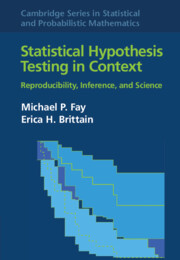Book contents
- Frontmatter
- Contents
- Preface
- 1 Introduction
- 2 Theory of Tests, p-Values, and Confidence Intervals
- 3 From Scientific Theory to Statistical Hypothesis Test
- 4 One-Sample Studies with Binary Responses
- 5 One-Sample Studies with Ordinal or Numeric Responses
- 6 Paired Data
- 7 Two-Sample Studies with Binary Responses
- 8 Assumptions and Hypothesis Tests
- 9 Two-Sample Studies with Ordinal or Numeric Responses
- 10 General Methods for Frequentist Inferences
- 11 k-Sample Studies and Trend Tests
- 12 Clustering and Stratification
- 13 Multiplicity in Testing
- 14 Testing from Models
- 15 Causality
- 16 Censoring
- 17 Missing Data
- 18 Group Sequential and Related Adaptive Methods
- 19 Testing Fit, Equivalence, and Noninferiority
- 20 Power and Sample Size
- 21 Bayesian Hypothesis Testing
- References
- Notation Index
- Concept Index
10 - General Methods for Frequentist Inferences
Published online by Cambridge University Press: 17 April 2022
- Frontmatter
- Contents
- Preface
- 1 Introduction
- 2 Theory of Tests, p-Values, and Confidence Intervals
- 3 From Scientific Theory to Statistical Hypothesis Test
- 4 One-Sample Studies with Binary Responses
- 5 One-Sample Studies with Ordinal or Numeric Responses
- 6 Paired Data
- 7 Two-Sample Studies with Binary Responses
- 8 Assumptions and Hypothesis Tests
- 9 Two-Sample Studies with Ordinal or Numeric Responses
- 10 General Methods for Frequentist Inferences
- 11 k-Sample Studies and Trend Tests
- 12 Clustering and Stratification
- 13 Multiplicity in Testing
- 14 Testing from Models
- 15 Causality
- 16 Censoring
- 17 Missing Data
- 18 Group Sequential and Related Adaptive Methods
- 19 Testing Fit, Equivalence, and Noninferiority
- 20 Power and Sample Size
- 21 Bayesian Hypothesis Testing
- References
- Notation Index
- Concept Index
Summary
This chapter briefly covers many general methods for calculating p-values and confidence intervals. We discuss likelihood ratios for inferences with a one-dimensional parameter. Pivot functions are defined (e.g., the probability integral transformation). Basic results for normal and asymptotic normal inferences are given, such as some central limit theorems and the delta method. Three important likelihood-based asymptotic methods (the Wald, score, and likelihood ratio test) are defined and compared. We describe the sandwich method for estimating variance, which requires fewer assumptions than the likelihood-based methods. General permutation tests are presented, along with implementation descriptions including equivalent forms, permutational central limit theorem, and Monte Carlo methods. The nonparametric bootstrap is described, as well as some bootstrap confidence interval methods such as the BCa methods. The melding method of combining two confidence intervals is described, which gives an automatically efficient method to calculate confidence intervals for the differences or ratios of two parameters. Finally, we discuss within-cluster resampling.
- Type
- Chapter
- Information
- Statistical Hypothesis Testing in ContextReproducibility, Inference, and Science, pp. 161 - 194Publisher: Cambridge University PressPrint publication year: 2022

